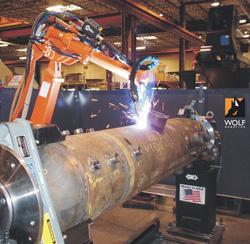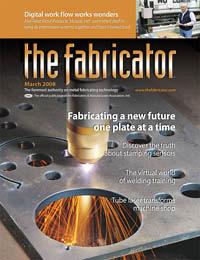- FMA
- The Fabricator
- FABTECH
- Canadian Metalworking
Categories
- Additive Manufacturing
- Aluminum Welding
- Arc Welding
- Assembly and Joining
- Automation and Robotics
- Bending and Forming
- Consumables
- Cutting and Weld Prep
- Electric Vehicles
- En Español
- Finishing
- Hydroforming
- Laser Cutting
- Laser Welding
- Machining
- Manufacturing Software
- Materials Handling
- Metals/Materials
- Oxyfuel Cutting
- Plasma Cutting
- Power Tools
- Punching and Other Holemaking
- Roll Forming
- Safety
- Sawing
- Shearing
- Shop Management
- Testing and Measuring
- Tube and Pipe Fabrication
- Tube and Pipe Production
- Waterjet Cutting
Industry Directory
Webcasts
Podcasts
FAB 40
Advertise
Subscribe
Account Login
Search
Automated pipe and tube welding
Robots make sense for many reasons
- By Chris Norris and Pat Clayton
- Updated May 8, 2023
- March 11, 2008
- Article
- Automation and Robotics

Robotic welding of tube and pipe means more control over a task that can be grueling for welders if done manually.
Encompassing applications ranging from exhaust systems and fenders to furniture and fencing, tube and pipe welding is a complicated task.
That's why robots make so much sense. Robots typically weld cold- and hot-rolled steel, stainless steel, and other sheet metals in a variety of shapes—round, square, and rectangle.
Of course, robotic automation is not limited to welding applications. But for the sake of this discussion, we'll concentrate on welding because moving from manual welding to automation is not always the easiest task.
Automated Pipe and Tube Welding 101
Manufacturers considering the switch to automation for their welding processes are faced with several questions:
Can the robot adapt to weld seam location?
Yes, with tactile sensing and through-the-arc monitoring, the robot will maintain the weld seam path.
What is the optimal joint preparation?
Most important is that you have a precise fitting of the joint. In addition, it is recommended that gaps are no larger than the thickness of the welding wire.
What are the main advantages of robotics compared to manual welding?
Consistent-quality welds, no missed welds, and shortened production time.
How do I avoid porosity and ensure acceptable weld quality?
Arc-data monitoring allows you to observe the welding process and ensure the parameters are maintained to accomplish the desired weld penetration.
What can be done to eliminate concern related to changeover time required for multiple pipe diameters?
Offline programming can reduce changeover time. The robot can be welding with minimal downtime with just a few touch-up points to ensure accuracy.
Automated Welding Challenges to Overcome
With some of the main questions out of the way, let's look at some of the specific obstacles that await fabricators considering robotic welding. Perhaps chief among those concerns is determining if you have the right application and environment for robots.
One of the biggest challenges is finding the proper fit of parts for acceptable welding conditions. For example, lack of fusion or burn-through may occur if weld joints have large gaps. In addition, large gaps require weaving, which may result in small holes.
Robots require a constant, level weld plane for the weld puddle, creating another challenge for you: maintaining the welding position between the robot and the part. To maintain the level platform, the robot must move in coordination with the positioner, which can be a problem when welding large pipes and square or rectangular tubes because they are not easily manipulated.
You also face challenges with part size. If the part is too small, the robot weld gun has trouble accessing or moving around the part; if the pipe is too large, multiple robots will be needed to reach around the part. You also need to address the thinness of the tube wall, as it will limit which processes are used to prevent burn-through.
The type of welding to be performed also poses obstacles. Many manufacturers prefer the quality of gas tungsten arc welding (GTAW) to gas metal arc welding (GMAW) because it works well with thin-gauge materials and is difficult to burn through. However, GTAW is much more difficult to automate because of its exposed electrode. When the electrode becomes contaminated, cleaning and realignment must take place before continuing—causing lengthy interruptions. GMAW electrodes are automatically fed and can be trimmed and realigned without an operator.
In addition, when tooling for welding attachments to the tube and pipe are needed, fixtures that hold the parts in place may interfere with welding equipment. Outdoor welding environments also can be a problem, as line systems there may not be able to accommodate robots.
While robots are the clear choice in preventing burn-through and eliminating and minimizing weld defects such as porosity and lack of fusion, they are not always the only option. Orbital tube and pipe welding machines should be used for small, thin tubes and straight weld seams. Because of limited access and other constrictions, inner-diameter welding is not the best application for robots either; however, saddle welding, a process that allows one pipe to wrap around another, is an ideal application.
To get the most bang for your buck, you should invest in improving the part manufacturing process for higher part tolerances and quality and design "robot-friendly" weld joints. Parts need to be consistent and accurate in dimension for repetitive part placement in fixtures, ensuring the weld locations are within a tolerance for locating the weld seam continuously over the production cycle. Robot-friendly joints locate the seam consistently, creating minimal gap.
Finally, part production timing is essential to ensure organization throughout the production process, which may require the operator to load several parts at once or multitask between interchanges.
Robots Working for Your Bottom Line
Once you determine automation is the appropriate strategy, an application engineer can find the best way to maximize performance from the robot system. The application engineer will need to address the amount of welding required to meet time and production commitments, and if any downtime is available for other parts and components. If required, the robot can be equipped with a tool changer for switching between two or more processes or welding wires. Typically, you can be up and running within days.
The return on investment for a typical robot system can be realized usually within six to 24 months, depending on the parts, complexity of the system, and learning curve of those who will be using the system. Quality improvements typically are seen immediately. In addition, by tracking the process, you can make changes to improve production time and determine the throughput of the system for accurate part production projections.
subscribe now

The Fabricator is North America's leading magazine for the metal forming and fabricating industry. The magazine delivers the news, technical articles, and case histories that enable fabricators to do their jobs more efficiently. The Fabricator has served the industry since 1970.
start your free subscription- Stay connected from anywhere

Easily access valuable industry resources now with full access to the digital edition of The Fabricator.

Easily access valuable industry resources now with full access to the digital edition of The Welder.

Easily access valuable industry resources now with full access to the digital edition of The Tube and Pipe Journal.
- Podcasting
- Podcast:
- The Fabricator Podcast
- Published:
- 04/16/2024
- Running Time:
- 63:29
In this episode of The Fabricator Podcast, Caleb Chamberlain, co-founder and CEO of OSH Cut, discusses his company’s...
- Industry Events
16th Annual Safety Conference
- April 30 - May 1, 2024
- Elgin,
Pipe and Tube Conference
- May 21 - 22, 2024
- Omaha, NE
World-Class Roll Forming Workshop
- June 5 - 6, 2024
- Louisville, KY
Advanced Laser Application Workshop
- June 25 - 27, 2024
- Novi, MI































